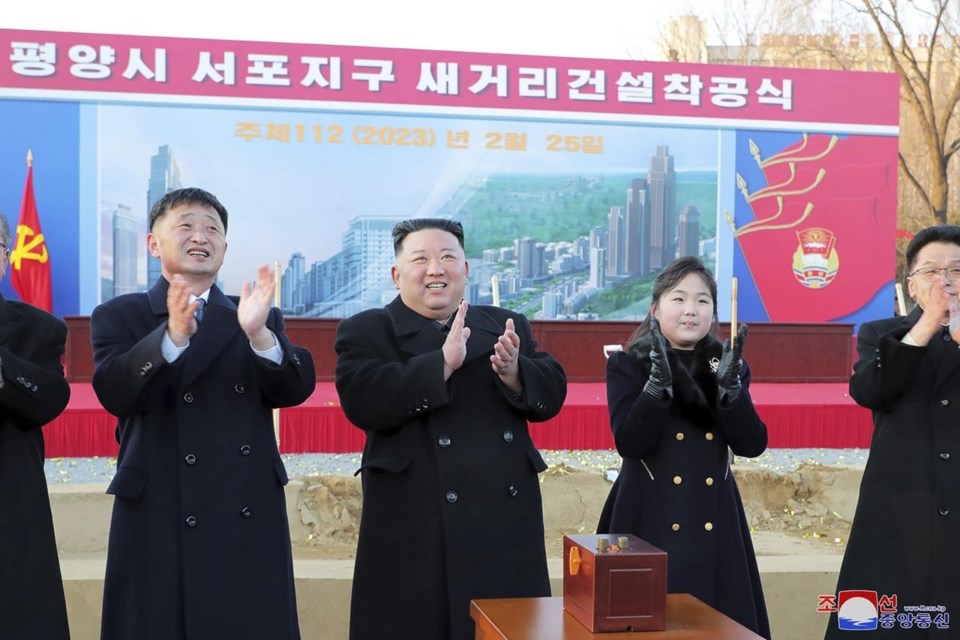SEOUL, South Korea (AP) — North Korean leader Kim Jong Un opened a major political conference dedicated to agriculture, state media reported Monday, as outside assessments suggest the country is facing a serious shortfall of food.
South Korean experts estimate that North Korea is short around 1 million tons of grain, nearly 20 percent of its annual demand, after the pandemic likely disrupted unofficial grain imports from China and the government has restricted food sales at markets.
Recent, unconfirmed reports in South Korean media have said that some North Koreans have died of hunger. But most experts have seen no indication of mass deaths or famine in North Korea.
During a high-level meeting of the ruling Workers’ Party that began Sunday, senior party officials reviewed last year’s work on state goals to accomplish “rural revolution in the new era,” the official Korean Central News Agency reported.
The report said that the plenary meeting of the party’s Central Committee will identify “immediate, important” tasks on agricultural issues and “urgent tasks arising at the present stage of the national economic development.”
KCNA didn’t say whether Kim spoke during the meeting or how long it would last. Senior officials such as Cabinet Premier Kim Tok Hun and Jo Yong Won, one of Kim’s closest aides who handles the Central Committee’s organizational affairs, also attended.
Plenary meetings are key decision-making venues for the Workers’ Party. In recent years, Kim has held a plenary meeting two to four times a year to formulate major policies.
It is the first time the party has convened a plenary session only to discuss agriculture. Monday’s report didn’t elaborate on its agenda, but the party’s Politburo said earlier this month that “a turning point is needed to dynamically promote radical change in agricultural development.”
Most analysts say North Korea’s food situation today is nowhere near the extremes of the 1990s, when hundreds of thousands of people died in a famine. However, some experts say its food insecurity is likely at its worst since Kim took power in 2011, after COVID-19 restrictions further shocked an economy battered by decades of mismanagement and crippling U.S.-led sanctions imposed over Kim’s nuclear program. Russia’s war on Ukraine possibly worsened the situation by driving up global prices of food, energy and fertilizer.
It’s unclear whether North Korea will take any significant steps to address food shortages. The impoverished country devotes much of its scarce resources to its nuclear program.
“To produce more grains, they should increase inputs such as fertilizers, pesticides and agricultural machines. But North Korea rarely comes up with such measures,” said Nam Sung-wook, a professor at Korea University in South Korea. “They have a limited budget. They can still take such steps (to produce more grain) with the money they’re spending on its missile development program.”
North Korea has accelerated missile tests since last year, launching more than 70 missiles, many of them nuclear-capable weapons that place the U.S. mainland, South Korea and Japan within striking distance.
Nam said the current food problems don’t pose a serious political threat to Kim, noting that his family’s rule wasn’t shaken even during the 1990s famine.
Last year, North Korea’s grain production was estimated at 4.5 million tons, a 3.8% drop from a year earlier according to South Korean government assessments. The North was estimated to have produced between 4.4 million tons to 4.8 million tons of grain annually from 2012-2021, according to previous South Korean data.
North Korea needs about 5.5 million tons of grain to feed its 25 million people annually, so it’s short about 1 million tons this year. In past years, half of such a gap was usually met by unofficial grain purchases from China, with the rest remaining as unresolved shortfall, according to Kwon Tae-jin, a senior economist at the private GS&J Institute in South Korea.
Kwon says trade curbs due to the pandemic have likely hindered unofficial rice purchases from China. Efforts by North Korean authorities to tighten controls and restrict market activities have also worsened the situation, he said.
South Korea’s Unification Ministry said the North’s current food shortage is more an issue of distribution than an absolute shortage, because much of the grain harvested last year has not been consumed yet.
Ministry officials said that the North’s food insecurity has worsened as authorities tightened controls over private grain sales in markets, instead trying to confine the grain trade to state-run facilities.
With the country’s factory and machinery sectors likely decimated by the border controls, Kim has been focusing on boosting grain production and reviving construction and other sectors that are less dependent on imported materials. Some experts say Kim likely aims to burnish his image as a leader who cares for public livelihoods as he seeks public support of his fight against U.S.-led sanctions and pressure campaigns.
State media reported that Kim and his “beloved” daughter broke ground Saturday on a project to build thousands of new homes in the Sopho district of Pyongyang, the capital. It was the seventh known public activity involving Kim’s daughter, believed to about 10 years old, since she made her first public appearance in November.
Last year, North Korea reopened freight train traffic with China and Russia and relaxed domestic restrictions, after it made a highly dubious claim that it had overcome the pandemic only three months after it acknowledged its first domestic outbreak. Analysts say it’s still unlikely that North Korea will completely end its curbs any time soon because many of its people remain unvaccinated and its public health care system is largely broken.
Kim Tong-hyung And Hyung-jin Kim, The Associated Press



